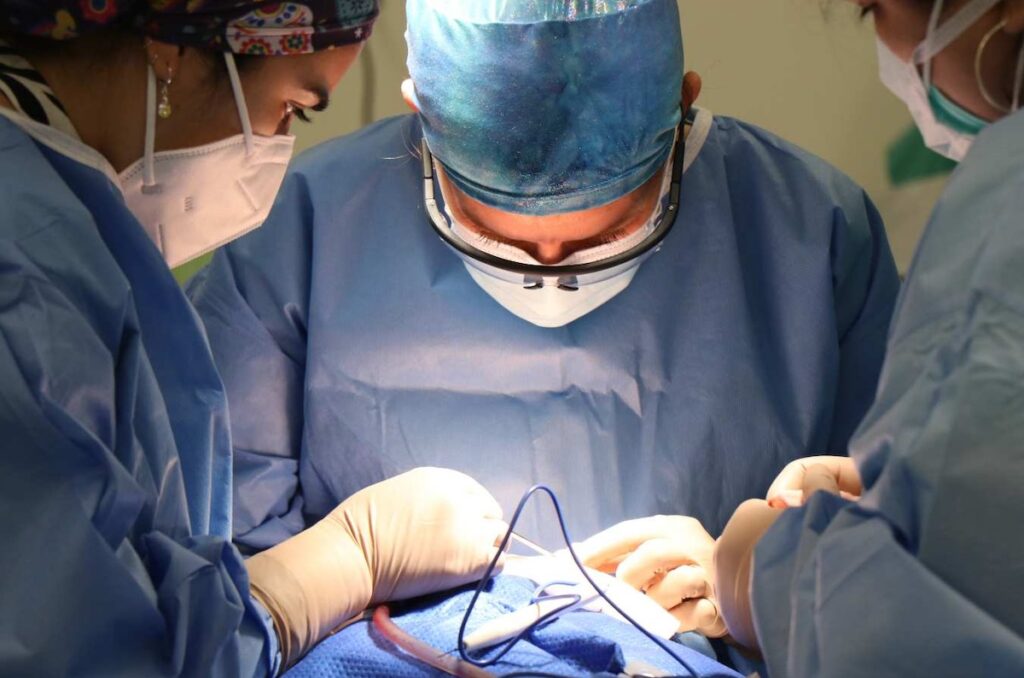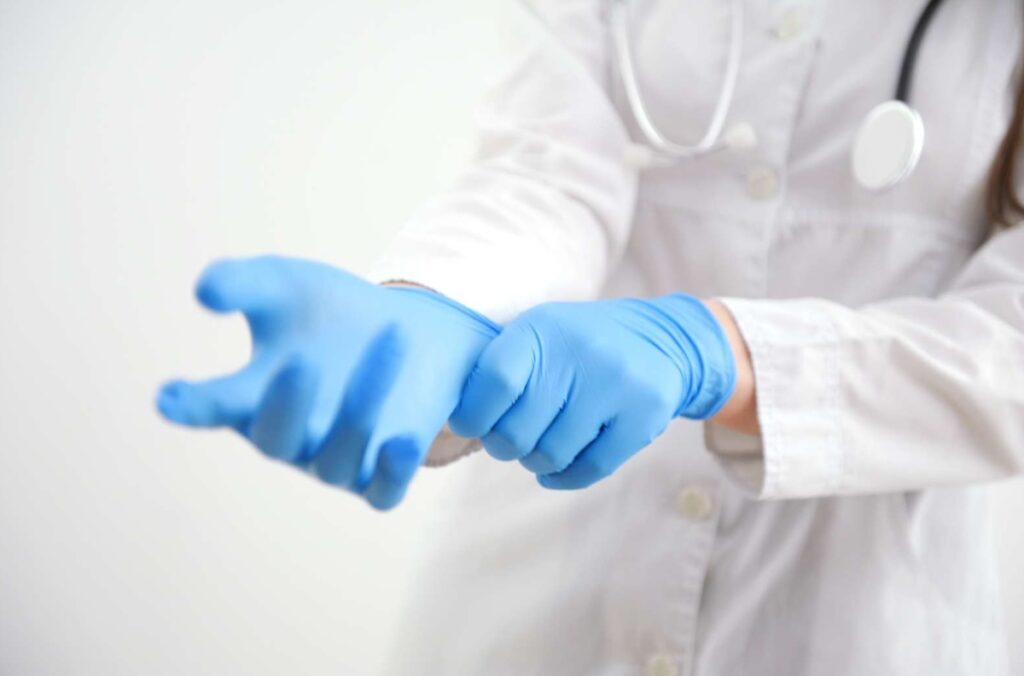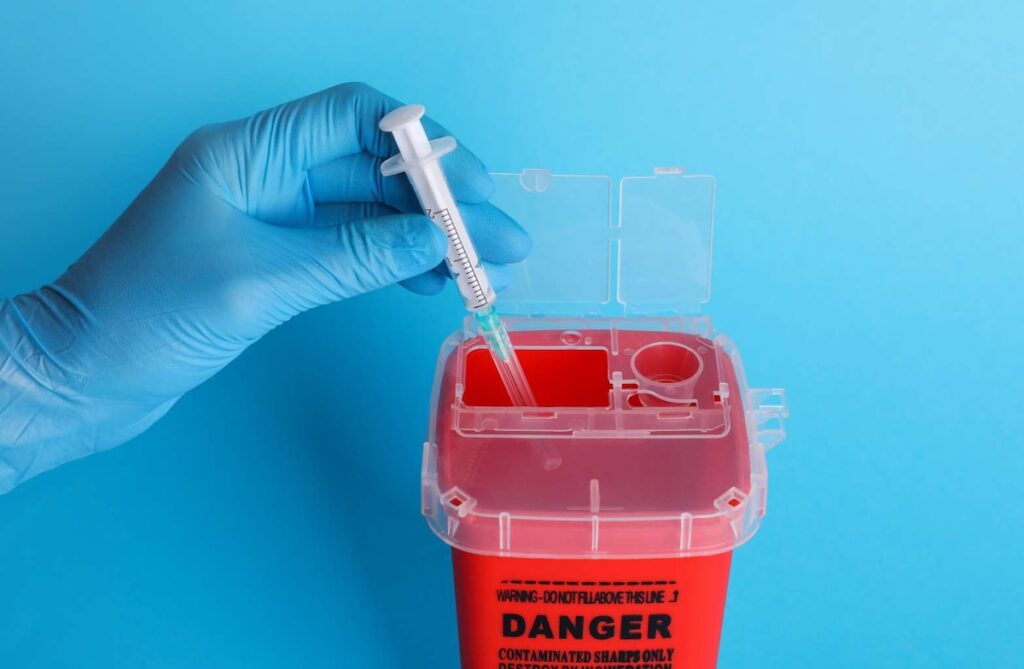Surgeons face many occupational health hazards or risks that may affect their well-being and performance but can be alleviated or removed. These hazards include injuries from instruments, chemicals, or other external factors; self-sustained body strains; bloodborne and airborne pathogens; and allergies.
Understanding the nature and causes of occupational risks in surgery is crucial for surgeon health and patient safety. This article explores specific surgeon health hazards and offers practical prevention strategies.
Sharps injuries
Sharps injuries are wounds caused by surgical instruments like scalpels, blades, or needles. Such injuries can range from minor cuts to severe lacerations. According to the American Journal of Infection Control, a surgeon will have a sharps injury in about one in ten surgeries.
What causes them?
Sharps injuries often arise from mishandling instruments, accidental instrument slips, or improper disposal of used needles and blades. A fast-paced workflow in the operating room can make this occupational hazard worse.
How can they be avoided?
To prevent sharps injuries, surgeons can use the double glove (or under-glove) technique, which involves putting two sets of gloves on. This practice reduces the risk of exposure to patient blood by as much as 87% when the outer set of gloves accidentally becomes punctured.
Surgeons can create a so-called safe or neutral zone in the form of a small rectangular basin or a magnetic pad placed close to the surgical field. This safe zone can help hold blades, needles, or other sharp instruments in place so that surgeons can access and pass them safely.
Specially designed tools also help avoid sharps injuries. Blunt-tip suture needles are a practical example of such tools: they have been shown to reduce the risk of needlestick injuries from suture needles by 69%.
Various guidelines, such as the AORN “Guideline for sharps safety”, provide instructions on recognizing sharps hazards and take measures to prevent sharps injuries.
Burns and scalding
Burns and scalding are thermal injuries — injuries caused by exposure to heat during surgery. These injuries lead to considerable discomfort and potential long-term skin damage.
What causes them?
Contact with hot instrument surfaces or chemicals, or accidental spills of hot liquids, are among the main causes of burns and scalding. Handling devices that use light scopes or heat to cauterize tissues and vessels also puts surgeons at risk.
How can they be avoided?
Surgeons should wear protective gear, such as heat-resistant gloves and aprons, when working with hot equipment. Proper training to increase awareness and skill when using and maintaining heat-producing devices also helps prevent burn hazards.
In addition, surgeons should be careful when operating with instruments with integrated light sources and cables—instruments commonly used in minimally invasive surgery. Surgeons should keep illuminated light cords away from drapes, the patient’s skin, and any flammable material and not turn on the light source before the cable is connected to the scope.
Slips, trips, and falls
Slips, trips, and falls are common accidents in the operating room that can injure surgeons and patients.
What causes them?
These accidents are usually caused by wet floors from spills, clutter from surgical supplies, device cables (like fiber-optic cables), or uneven surfaces in the operating room. High-pressure situations often lead to hasty movements, increasing the risk of accidents.
How can they be avoided?
Preventing such accidents is a team effort. Surgical team members should maintain clear communication at all times, be informed about the procedure and the equipment that will be used, and keep the operating room clutter-free, appropriately lighted, and keep the floors dry.
Modern devices such as the Yasui koplight™ lighted retractor can also help reduce wiring in the OR.
Another recommendation is using surgical or operating room booms. These devices provide easy access to electrical power, audio-visual data, and medical gases and keep cords and cables out of the way.
Posture and body movement injuries
Posture and body movement injuries are occupational hazards affecting the body’s muscles and joints. In the long term, these injuries can lead to devastating musculoskeletal disorders involving the neck, back, and shoulders. A study analyzing surgeons’ ergonomics and musculoskeletal health found that more than 80% of surgeons complain of a work-related injury or illness stemming from awkward or static positions.
What causes them?
Posture and movement injuries result from holding the same postures over the operating table for extended periods or making repetitive movements. A lack of ergonomic support contributes to the problem.

How can they be avoided?
Surgeons should be mindful of their posture, use ergonomic instruments, and adjust table and patient positioning depending on the procedure type. The American College of Surgeons offers a helpful guide (PDF) on recommended intraoperative ergonomic measures that surgeons can take to protect themselves.
Although frequently ignored, regular breaks to stretch and change positions are essential for preventing strains. Furthermore, hospitals can implement exercise programs directed by trained therapists to improve the surgeons’ posture, strength, and stability.
Work-related stressors are factors associated with the physical and mental demands placed on surgeons before, during, and after procedures.
What causes them?
The demanding nature of surgeries, coupled with understaffing, work overload, lack of support, and the need to meet patient expectations and manage unexpected complications, contributes to elevated stress levels. Excessive stress can impair a surgeon’s hand-eye coordination and affect teamwork and decision-making. In the long run, it can lead to burnout, mental health disorders, substance abuse, and high divorce rates.
How can they be avoided?
There is no universal formula for eliminating stress factors. The American College of Surgeons recommends that surgeons adopt stress management techniques, such as mindfulness and regular exercise, to combat stress. It also suggests incorporating mental skills training to optimize surgical performance. Institutions can consider providing psychological support, reducing excessive workloads, and promoting a supportive work environment.
Bloodborne pathogens
Bloodborne pathogens are microorganisms that travel through the blood and can cause infections. These include viruses like HIV (human immunodeficiency virus), hepatitis B virus, and hepatitis C virus.
What causes them?
Exposure to blood and other bodily fluids during surgeries is the primary risk factor. Sharps injuries or splashes of blood can facilitate the transmission of these pathogens.
How can they be avoided?
Surgeons should adhere to good practice standards, such as the Bloodborne Pathogens Standard by the U.S. Occupational Safety and Health Administration (OSHA), to reduce the risk of infection. Such standards protect surgeons and healthcare workers against health hazards related to bloodborne pathogens by promoting instrument control plans, vaccinations and the use of personal protective equipment (PPE) like double gloves, face masks, goggles, and gowns.
Airborne pathogens
Airborne pathogens are microorganisms that can be transmitted through the air and pose a risk to surgeons during procedures. These include bacteria, viruses, and fungi that may lead to infections. A recent (mischievous) example is the SARS-CoV-2 virus.
What causes them?
Pathogens can be released into the air when using aerosol-generating devices or when the operating room has inadequate ventilation.
How can they be avoided?
Surgeons can avoid airborne pathogens by working in an environment that promotes strict infection control measures, including high-efficiency particulate air (HEPA) filters and proper ventilation. Surgeons should also follow rigorous hand hygiene practices and wear appropriate personal protective equipment (PPE), including face masks or respirators.
Chemical liquids and gases
Hazardous chemicals and gases in the operating room are substances regularly used during surgery, which may have toxic effects on surgeon health.
What causes them?
Surgeon health can be compromised by exposure to the following substances:
- Waste anesthetic gases (WAGs) — volatile anesthetics, such as halothane, that leak during anesthesia procedures
- Disinfectants, such as iodine or isopropyl alcohol
- Aerosolized particles
How can they be avoided?
Implementing specialized ventilation systems like chemical fume hoods can help lower exposure to harmful chemicals and gases in the operating room. Surgeons must habitually use personal equipment to protect themselves. However, it is the responsibility of the healthcare institution to regularly monitor the presence and level of potentially toxic substances in the working environment.
Laser plumes
Laser plumes are smoke-like by-products produced when lasers are used in surgery. These plumes can contain harmful chemicals and cellular material.
What causes them?
Laser devices used to cut or coagulate tissue generate laser plumes, which can create potentially hazardous fumes due to the high temperatures involved.
How can they be avoided?
Operating rooms should incorporate effective smoke evacuators and proper ventilation to mitigate the risks associated with laser plumes. Ventilation systems require regular maintenance and inspection. Surgeons should wear appropriate protection equipment and properly utilize laser devices to further reduce health risks.
Harmful radiation
Radiation hazards in the surgical field involve the health risks caused by intense or long-term exposure to ionizing or non-ionizing radiation. This exposure can lead to long-term health issues.
What causes it?
Radiation exposure is caused by using X-rays, fluoroscopes, or laser-based equipment during surgeries. Prolonged exposure, especially without adequate protection, increases the risk of radiation-related health problems, such as burns, cataracts, carcinogenesis, and hair loss.
How can it be avoided?
All surgeons should practice general radiation safety techniques, including shielding, distance, and fluoroscopic dose reduction. Shielding involves minimizing radiation exposure by using lead aprons, thyroid shields, and other protective gear. Adequate training on reducing exposure and optimizing imaging techniques also helps combat this hazard.
Latex allergies
Latex allergies represent hypersensitivity reactions to proteins found in natural rubber latex, a material commonly used in medical gloves and other products.
What causes them?
Frequent contact with latex gloves and other latex-containing products can lead to sensitization and allergic reactions. Symptoms can range from mild skin irritation to severe anaphylactic responses.

How can they be avoided?
To prevent latex allergies, surgeons should use latex-free gloves and avoid contact with latex-containing medical products, such as catheters, tapes, electrode pads, blood pressure cuffs, elastic bandages, and wraps. Instead of latex gloves, surgeons can consider using vinyl, nitrile, or polymer gloves, which are appropriate for infectious materials.
Noise pollution
Noise pollution in the operating room represents the various harmful sounds associated with the workflow in the operating room. Prolonged exposure to high noise levels can impair hearing and contribute to stress and intraoperative mistakes. Noise levels in orthopedic theaters are especially problematic, as saws and drills can exceed the recommended daily noise exposure level of 85 decibels.
What causes it?
The operation of surgical instruments, equipment alarms, and the need for constant verbal communication between the surgical team members are the primary causes of noise in the operating room.
How can it be avoided?
Preventing noise pollution starts with proper education of surgical team members on the importance of quiet communication and prevention of nonessential talk. Hospitals should consider measuring noise levels within the operating room to assess whether they exceed levels recommended by organizations such as the U.S. Environmental Protection Agency (EPA) or World Health Organization (WPO). In this regard, hospital administrators should consider implementing noise-absorbing walls, automatic doors, and less noisy alternatives for surgical instruments.

